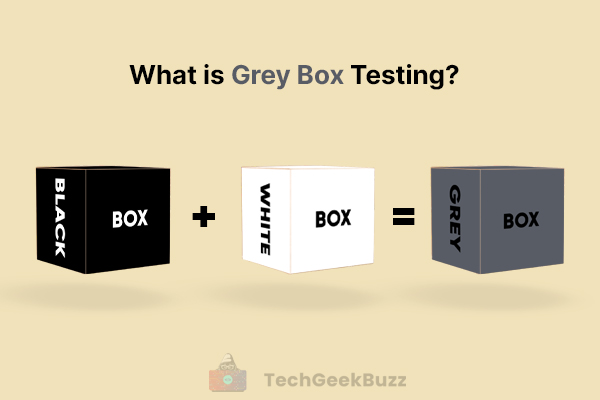A software testing technique is a well-structured approach to carrying out testing on a software product under development against functional and non-functional requirements.
Grey box testing is a popular software testing technique that combines various features of white box testing and black-box testing. Grey box testing, also referred to as translucent testing, is an ideal testing technique to use when testers have incomplete knowledge of the software product’s internal structure. Also, this type of testing is best suited for web-based applications .
Here, in this article, we shall walk you through grey box testing, along with its objectives, upsides, downsides, process, and various techniques.
So, let us get started!
What is Grey Box Testing?
Grey box testing is a type of software testing technique to test a software product or application with partial knowledge of its internal structure and implementation details. It is an amalgamation of black-box testing and white-box testing.
In this type of testing technique, testers have the right to access the documentation of the data structure and algorithms used to develop the software product's internal structure. Using this documentation, they design the test cases required for carrying out testing. However, they have limited knowledge of the working of the components they are testing.
This is in contrast to the black box and white box testing. Black box testing tests the software product’s functionality without knowing its internal structure and implementation details. On the other hand, white box testing tests the working of the software product by inspecting its internal design and code structure.

Since grey box testing involves partial knowledge of the internal structure of the application under development, it is referred to as translucent testing.
The primary purpose of this type of testing technique is to identify defects that may be caused due to improper structure or improper usage of the software product. It covers both functional and non-functional testing together, which improves the overall quality of the product.
Objectives
The objectives of the grey box testing are to:
- Have combined benefits of black-box testing and white box testing.
- Combine the input of developers and testers.
- Improve the overall quality of the software product under development.
- Reduce the overhead and time required for the long process of functional and non-functional testing.
- Provide developers with enough free time to fix defects.
- Test the software product from end users’ perspective and not from the designer’s point of view.
Advantages of Grey Box Testing
Here are some remarkable advantages of translucent box testing:
- Both developers and testers have clear goals while executing this type of testing technique.
- There is no need for testers to have in-depth programming knowledge.
- It is non-intrusive.
- It improves the overall performance and quality of the software product.
- Developers get enough time to fix defects.
- It is unbiased. Therefore, there are no conflicts between testers and developers.
- This testing technique proves to be beneficial in complex applications or scenarios.
- It is more effective in integration testing and penetration testing.
Disadvantages of Grey Box Testing
Some notable drawbacks of translucent box testing are as follows:
- Testers have limited access to the internal structure of the software product, which results in limited code path traversal.
- Since testers do not have access to the source code, they cannot perform complete white box testing.
- Sometimes, it becomes pretty challenging to design test cases.
- It is not ideal for algorithm testing.
- When testers perform this type of testing on distributed systems, they find it difficult to associate defects.
Example
Let us take one simple example of testing a website. While testing a website, testers click on all the available links to check if they work as intended or not. If they encounter errors with any of the links on the website, they directly make changes to the HTML code and check those changes in real-time.
Steps to Perform Grey Box Testing
The following are the steps that testers carry out to perform translucent testing:
- Select Input: Identify and select white box testing and black box testing inputs.
- Identify Output: Identify outputs for the corresponding inputs selected in the above step.
- Find the Key Paths: Identify all the major paths that you need to traverse while testing the software product.
- Identify Sub-functions: Identify all the sub-functions to take testing to the next level.
- Find the Input of Sub-functions: After determining sub-functions, identify the input of those sub-functions.
- Identify the Output of Sub-functions: Find out the output of each sub-function in this step.
- Test Cases Execution: Design test cases for each sub-function and execute them.
- Verification of Results: In this step, testers verify whether the results of test cases are as expected.
This process continues each time the new sub-function is identified. In addition, the test cases designed for grey box testing are related to a browser, security, GUI, operating system, and database.
Grey Box Testing Techniques
There are four different grey box testing techniques, namely matrix testing, regression testing, orthogonal array testing, and pattern testing. Let us discuss each of these techniques in detail below.
1. Matrix Testing
In matrix testing, testers are responsible for determining the business and technical risks associated with the software product under development. Also, developers define all the variables used in the source code of the software product.
The primary role of testers is to identify and remove the variables that are of no use in the source code. Doing this automatically increases the speed of the software product and also the readability of the source code.
2. Regression Testing
Regression testing is a type of testing technique that involves testing the software product after every change in its source code. Testers carry out regression testing to ensure that any changes to the source code do not affect its existing functionality. Also, this technique ensures that fixing any defects does not affect the other functionality of the software product.
3. Orthogonal Array Testing
In orthogonal array testing, there is n number of permutations and combinations for test data. This technique is ideal when you have a few test cases, large test data, and require maximum test coverage. You can opt for this technique to test complex applications.
4. Pattern Testing
Testers carry out pattern testing based on the previous defects they found in the software product. They determine the root cause of the defect by looking at previous defects from the defect record. Accordingly, they also create test cases based on the previous defects so that they find more defects before making the software product live.
Conclusion
Grey box testing is a combination of white-box testing and black-box testing, where testers have partial knowledge of the software product’s internal structure and functionality of the source code. They have access to documentation containing information related to data structures and algorithms used to develop the internal structure.
We hope this article has helped you understand grey box testing, its techniques, and the steps involved in grey box testing. If you have any questions related to grey box testing, feel free to share them in the comments section.
People are also reading:
![What is Grey Box Testing? [Definition and Techniques]](/media/new_post_images/Grey-Box-Testing.webp)


![What is Waterfall Model? [Phases, Pros, & Cons]](/media/new_post_images/Waterfall_Model.webp)

Leave a Comment on this Post